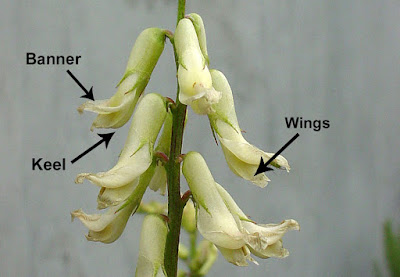 |
| Rattlepod (Astragalus trichopodus var. lonchus) - Mother Nature's Garden of Health |
Despite forecasts
of a strong El Niño season, we’re currently at only about half our normal
rainfall. That’s worrisome! We’ve
been watering Mother Nature’s Gardens, trying to saturate the soils, as they
should be this time of year. One plant
that’s blooming right on target is the Rattlepod, Astragalus trichopodus.
Rattlepod
is known by several common names including Santa Barbara milkvetch, Three-pod milkvetch,
Ocean locoweed and Ocean milkvetch. We
prefer ‘Rattlepod’; a name that well depicts the plant’s most unusual feature. Three varieties of Astragalus trichopodus grow in Los Angeles County. Astragalus
trichopodus var. phoxis grows in
the foothills of the Santa Monica Mountains, but is more common in the inland
foothills of Los Angeles County (San Gabriel Mountains). Astragalus
trichopodus var. trichopodus is
found on Santa Catalina Island and the inland Puente Hills.
Astragalus trichopodus var. lonchus – the most common variety in Western Los Angeles County –
was once widespread on the coastal plains and Channel Islands (less than 1000
ft. elevation) from San Luis Obispo County to San Diego County and Baja
California, Mexico. Locally, it once
grew on the coastal bluffs and coastal prairies of Playa del Rey, Hermosa and
Redondo Beach and San Pedro. Specimens
were also collected from the Dominguez Slough (now Gardena Willows Wetland
Preserve). Planting Rattlepod in our
Garden of Health brings this plant home.
We hope to use seeds from our garden to re-populate Rattlepod on the
Preserve.
 |
| Rattlepod (Astragalus trichopodus var. lonchus) - growth habit |
Since
Astragalus trichopodus var. lonchus is the type grown in our garden,
we’ll focus the rest of this article on that variety. Rattlepod is an herbaceous perennial in the
Pea family (Fabaceae). It dies back to the ground in the dry season,
emerging again with the cool rains of winter and early spring. Once conditions are satisfactory, it quickly
grows to a bushy, somewhat sprawling perennial, 2-3 ft. tall and about 3 ft.
wide. Although the stems are stout, they
are herbaceous. The high winds last
weekend knocked a few branches off the plant in our garden.
 |
| Rattlepod (Astragalus trichopodus var. lonchus) - compound leaves |
The
foliage is a bright spring green – the color of garden peas. Like most in the family, the leaves are
compound, with 15-40 rounded leaflets along a midrib that can be up to 8 inches
long (see above). The leaves of local
plants are modestly hairy. We find the
foliage to be unusual and attractive in the garden setting. All
parts of the plant are toxic if eaten. This explains the common name ‘Locoweed’:
domesticated horses, cows and sheep can become quite ill if they eat too much
milkvetch.
 |
| Rattlepod (Astragalus trichopodus var. lonchus) - blooming plant |
 |
| Rattlepod (Astragalus trichopodus var. lonchus) - close-up of flowers |
Rattlepod
is an early-flowering species. It can begin
blooming as early as January and almost never flowers later than early April in
our area. The flowers are a waxy cream-white
and are arranged around upright stems. On close inspection (above), the individual
flowers exhibit the usual characteristics of members of the Pea family. You can clearly see the banner and keel on
the photograph above. The early flowers
attract bees and other insects.
 |
| Rattlepod (Astragalus trichopodus var. lonchus) - green pods |
 |
| Rattlepod (Astragalus trichopodus var. lonchus) - dry pods |
The
seedpod of Astragalus trichopodus is
rounded and inflated; the dry seeds rattle in dry seedpods, which explains this plant’s
common name. While other vetches have
inflated seedpods, Rattlepod deserves special attention; its pods are puffed up
like little balloons. The pods are 1/4"
to 3/4" wide and 1/2" to 1-3/4" long. Green when young, they gain pink tinges as
they mature, finally becoming dried and tan (see above). Each pod contains up to 20 or so, pea-like
seeds that become wrinkled when dry.
Rattlepod
is very drought tolerant. A long taproot
partially explains this plant’s drought tolerance. But the Rattlepod’s yearly cycle is also
geared to our long dry season. Plants
die back to the roots for the dry period – a pretty good strategy for such an
herbaceous plant. For more on drought
tolerance see: http://mother-natures-backyard.blogspot.com/2015/10/how-things-work-plant-drought-tolerance.html
Local
gardeners on the Palos Verdes peninsula plant Astragalus trichopodus in the hopes of providing larval food for
the endangered Palos Verdes Blue butterfly (Glaucopsyche
lygdamus palosverdesensis). We like the plant because it also attracts
other interesting insects – pollinators, early butterflies and others. The flowers and plant are pretty, and
contrast well with other native plants. Rattlepods
provide good winter-spring fill around larger plants. They also look nice with locally native cool
season grasses, spring annual wildflowers and Wallflowers.
 |
| Rattlepod (Astragalus trichopodus var. lonchus) - Madrona Marsh Preserve |
We are
not entirely sure whether Astragalus trichopodus has medicinal value or not. Asian Astragalus
species are used for a variety of ailments, including viral illnesses.
Chemicals made by several Astragalus species are being tested as possible
cancer and AIDS treatment drugs. That
being said, California native Astragalus species are toxic and should not be eaten. We’ll just have to wait and see whether compounds
from local natives will be added to the medicine bag of the future.
 |
| Rattlepod (Astragalus trichopodus var. lonchus) with Dune Wallflower - Madrona Marsh Preserve |
For a
gardening information sheet see: http://www.slideshare.net/cvadheim/gardening-sheet-astraglus-trichopodus
For more
pictures of this plant see: http://www.slideshare.net/cvadheim/astragalus-trichopodus-web-show
For plant
information sheets on other native plants see: http://nativeplantscsudh.blogspot.com/p/gallery-of-native-plants_17.html
We welcome your comments (below).
You can also send your questions to: mothernaturesbackyard10@gmail.com

Thanks for the info. The gardening sheets are good, too. I see the pronunciation is on the gardening sheet, but not in this blog post. So many people get confused about pronunciation - would you consider adding it to these posts?
ReplyDelete